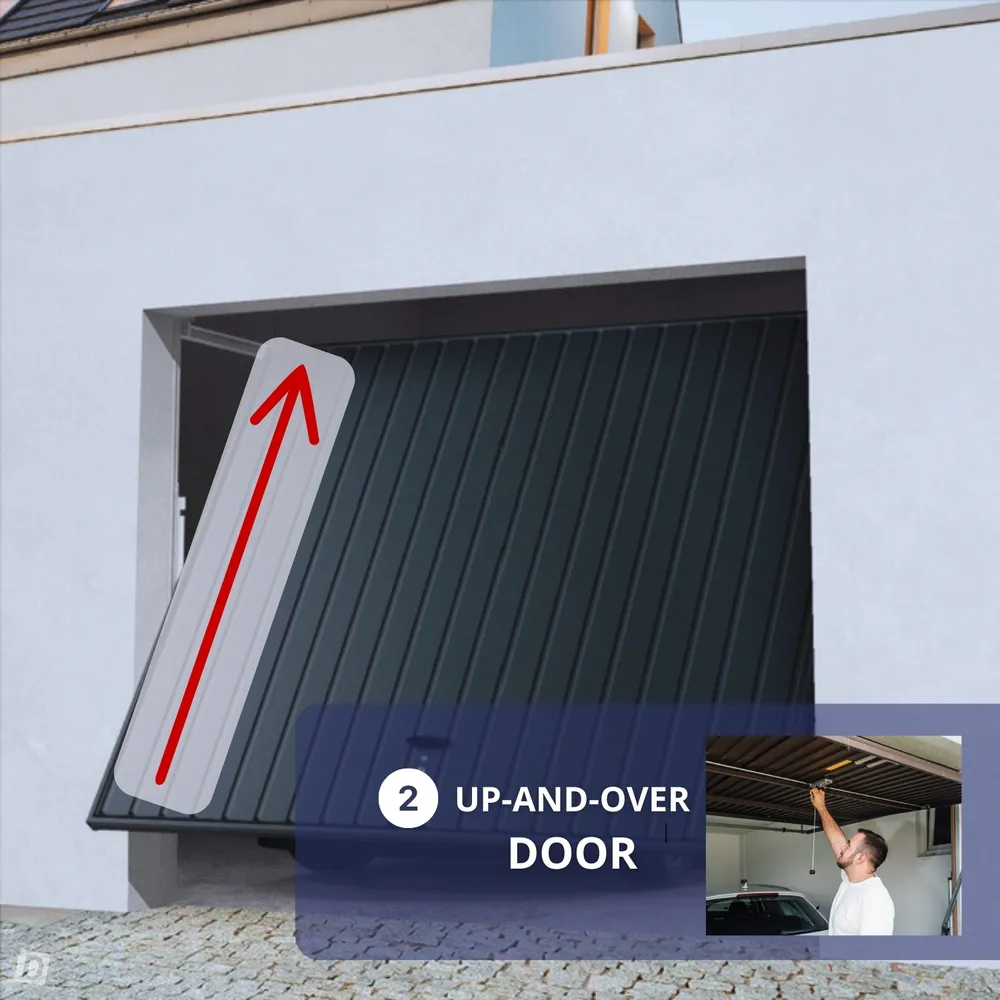The Different Types of Garage Doors: Complete Guide to Making the Right Choice
Choosing the right garage door is essential for combining security, comfort, and aesthetic appeal to your home. Depending on your garage’s layout, the level of thermal and sound insulation you want, or your design preferences, you’ll find several types of garage doors: sectional, roll-up, up-and-over (projecting or non-projecting), side-hinged, and sliding.
Each model has unique features to meet various needs, particularly regarding space availability and motorization systems. Domobip, a specialist in motorization remote controls, offers compatible solutions for each type of door to simplify your daily use.
What Are the Types of Garage Doors and Their Characteristics?

1. Sectional Door
The sectional garage door consists of articulated panels that slide vertically and tuck under the garage ceiling.
It offers significant space savings and excellent thermal insulation, especially when the panels are filled with polyurethane foam.
Advantages: space-saving, ideal for small garages, excellent thermal and sound insulation.
Drawbacks: technical installation, requires free ceiling space.
Ideal for: garages integrated into the house and homes where insulation is a priority.
Motorization: easily motorized with guide rails and compatible remote controls.
2. Up-and-Over Door
The up-and-over garage door is made of a single panel that tilts upward and slides under the ceiling.
It comes in two versions: projecting (requires exterior clearance) and non-projecting (remains inside the garage).
Advantages: economical, robust, simple design.
Drawbacks: requires exterior space for the projecting version.
Ideal for: detached garages, garages requiring a cost-effective solution.
Motorization: compatible with motorization systems for more convenient use.
The projecting version requires exterior clearance and is suitable for garages with enough space in front of the door (such as a wide driveway or yard).
For restricted spaces or garages opening directly onto the street, the non-projecting version is preferable because it opens without crossing the garage’s boundary toward the outside.


3. Roll-Up Door
The roll-up garage door works like a roller shutter, with slats that roll into a box located above the garage opening.
Ideal for small garages or layouts that require optimizing interior space, it is simple and practical.
Advantages: compact, perfect for garages with limited ceiling space.
Drawbacks: generally lower thermal insulation compared to other models.
Ideal for: garages with low ceiling height or those prioritizing a rolling mechanism.
Motorization: compatible with motorization.
4. Side-Hinged Door
The side-hinged garage door consists of two leaves that open outward.
Though less common today, it remains a simple and economical solution.
Advantages: easy installation, cost-effective, ideal for wooden or double-wall steel garages.
Drawbacks: requires significant outdoor space.
Ideal for: detached garages where no technical installation constraints exist.


5. Side-Sliding Door
The side-sliding (or lateral sectional) garage door slides along a wall, allowing pedestrian access without opening the entire door.
It also frees up ceiling space for storage or other installations.
Advantages: practical for garages with unavailable or cluttered ceilings, easy pedestrian access.
Drawbacks: requires a free, unobstructed wall for movement.
Ideal for: garages where ceiling space is already used or for garages with frequent access.
Motorization: easily motorized for daily use.
Criteria to Consider When Choosing Your Garage Door
To choose the right garage door, several criteria must be taken into account:
Opening type: choose vertical, lateral, or side-hinged opening depending on the space available.
Material: aluminum garage door for easy maintenance, galvanized steel for more strength...
Thermal and sound insulation: sectional doors are known to provide the best insulation performance.
Enhanced security: opt for models with an anti-lift system.
Customization: it is possible to personalize your garage door...
Budget: the price of a garage door depends on the model...
Motorization and Remote Controls for Daily Comfort
Adding motorization is a real asset to improve daily comfort and convenience when using your garage door.
Domobip offers a range of remote controls, motors, and accessories compatible with well-known motorization systems.
FAQ
Are you planning to add motorization to a manual garage door?
Good news: motorization is compatible with most door types, including up-and-over and roll-up doors.
What about the budget?
The price of a garage door depends on several factors, including the model, materials, and motorization options.
Is maintenance necessary?
Absolutely ! Regular maintenance will extend the life of your installation, keeping the motorization and guide rails in excellent condition.
So, Which Type of Garage Door Best Meets Your Needs?
Whether you choose a sectional, roll-up, side-hinged, sliding, or up-and-over door, the right motorization and accessories will provide you with unmatched daily comfort.
Discover Domobip’s selection of compatible remote controls and motorization accessories for safe and optimized use of your garage door!
